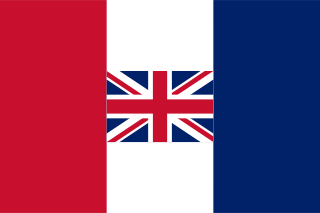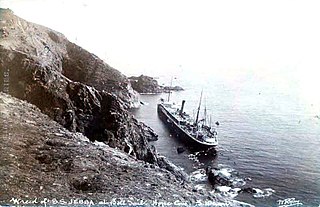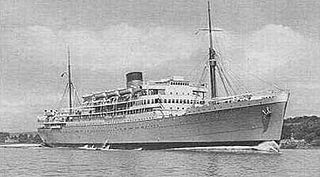
SS Ceramic was an ocean liner built in Belfast for White Star Line in 1912–13 and operated on the Liverpool – Australia route. Ceramic was the largest ship serving the route until P&O introduced RMS Mooltan in 1923.

P Henderson & Company, also known as Paddy Henderson, was a ship owning and management company based in Glasgow, Scotland and operating to Burma. Patrick Henderson started business in Glasgow as a merchant at the age of 25 in 1834. He had three brothers. Two were merchants working for an agent in the Italian port of Leghorn; the third, George, was a sea captain with his own ship.

SS Akaroa was a UK steam ocean liner and refrigerated cargo ship. She was launched in 1914 in Ireland as Euripides for Aberdeen Line. When new, she was the largest ship in the Aberdeen Line fleet.

SS Clan Alpine was a UK steam cargo liner. She was launched in 1918 and sunk by a U-boat in 1943.
SS Montrose was a British merchant steamship that was built in 1897 and wrecked in 1914. She was built as a cargo liner for Elder, Dempster & Company. In 1903 the Canadian Pacific Railway bought her and had her converted into a passenger liner.
SS Clan Macneil was a UK steam cargo liner. She was launched in 1921, survived the Second World War and scrapped in 1952. She spent her entire career with Clan Line.

SS Polar Chief was a merchant steamship that was built in England in 1897 and scrapped in Scotland in 1952. In its 55-year career it had previously been called Montcalm, RFA Crenella, Crenella, Rey Alfonso, Anglo-Norse and Empire Chief. Early in the First World War it spent eight months pretending to be the battleship HMS Audacious.
Ramón Alonso R. was a merchant steamship that was built in Scotland in 1898 and scrapped in Spain in 1959. Her original name was Montclair. She was renamed José Gallart in 1901, Balmes in 1911 and Ramón Alonso R. in 1929. Her first owner was the British Elder Dempster Lines, but she spent most of her career with a succession of Spanish owners. She was built as a transatlantic ocean liner with some cargo capacity, but in 1927 she was refitted as a cargo ship. In 1913, when she was called Balmes, the ship survived a serious cargo fire in mid-Atlantic.
MV Abosso was a passenger, mail, and cargo liner, the flagship of Elder Dempster Lines. In peacetime she ran scheduled services between Liverpool and West Africa. In the Second World War she was a troop ship, running between the United Kingdom, West Africa, and South Africa.
SS Yoma was a British passenger liner that served as a troop ship in the Second World War. She was built in Scotland in 1928, and from then until 1940 Yoma ran a regular route between Glasgow in Scotland and Rangoon in Burma via Liverpool, Palma, Marseille and Egypt. She became a troop ship in 1941 and was sunk with great loss of life in the Mediterranean in 1943.
Captain James Hackman ("J.H.") Tachie-Menson was an African pioneer and musician, widely recognized as the first African Master Mariner/Ship's Captain. He gained additional recognition as the author of a number of choral compositions that have been performed by various choirs and musicians in Africa, the United Kingdom, and the United States.

SS City of Leeds was a British North Sea passenger and cargo steamship that was built in Yorkshire in 1903 and scrapped in Northumberland 1937. In the First World War the Imperial German Navy captured her and used her as a depot ship.

SS New Australia was a UK-built turbo-electric passenger steamship that had a varied career from 1931 to 1966. She was built as the ocean liner Monarch of Bermuda, was a troop ship in the Second World War and was damaged by fire in 1947.

SS Jebba was a steamship that was built in Middlesbrough in 1896 and wrecked on the south coast of Devon in 1907. She was launched as Albertville for the Compagnie Belge-Maritime du Congo (CBMC), and was renamed Jebba when Elder, Dempster & Co acquired her in 1898. She was the first of four CBMC ships to be called Albertville, and the first of two Elder, Dempster ships to be called Jebba.

Killick Martin and Company Ltd is a privately owned global transport and logistics company with its head office in the United Kingdom. The company can trace its origins back to 1861 when it was founded by Captain James Killick and James Henry Martin. The company provides ocean freight, air freight, road freight, customs clearance, warehousing and supply chain management services. The company today has 5 offices in the United Kingdom and a global network of agencies. The ultimate parent company is Atlantic Pacific Group Ltd.

HMS Dunvegan Castle was a UK ocean liner that was converted into an armed merchant cruiser (AMC) in the Second World War. Harland and Wolff built her and her sister ship Dunnottar Castle in Belfast in 1936.
MV Asiatic Prince was a motor cargo liner that was built in Germany in 1926, operated by a British shipping line, and disappeared without trace in the Pacific Ocean in 1928. When she was lost she was carrying silver bullion worth £263,000.
MV Henry Stanley was a UK cargo motor ship that traded between Liverpool and West Africa. She was launched in 1929 in Scotland and sunk in 1942 in the North Atlantic.














